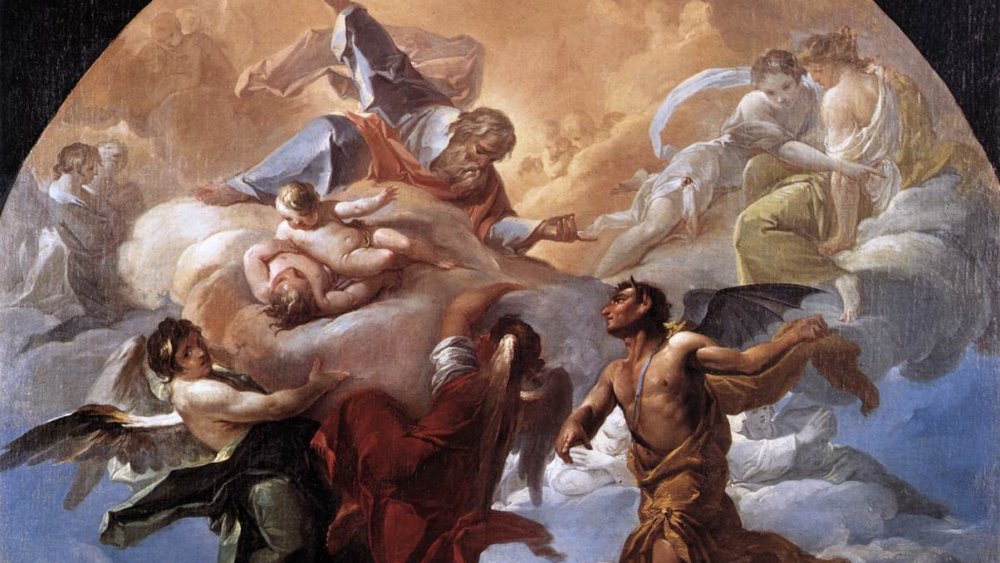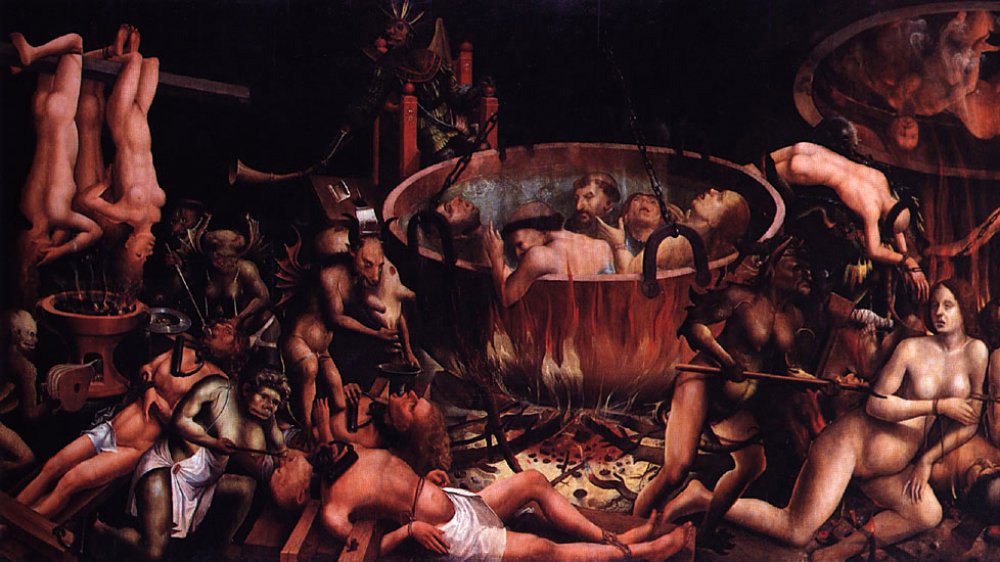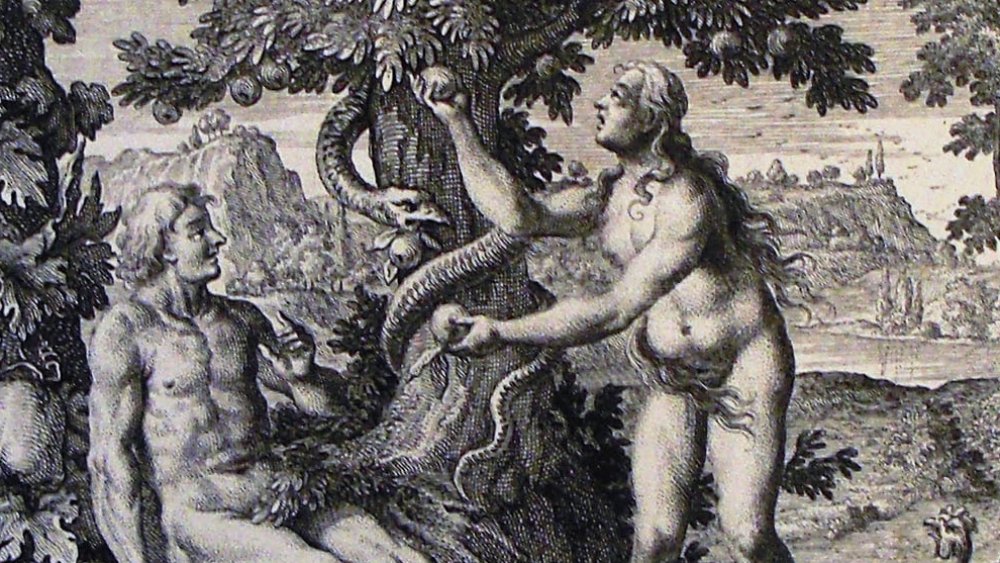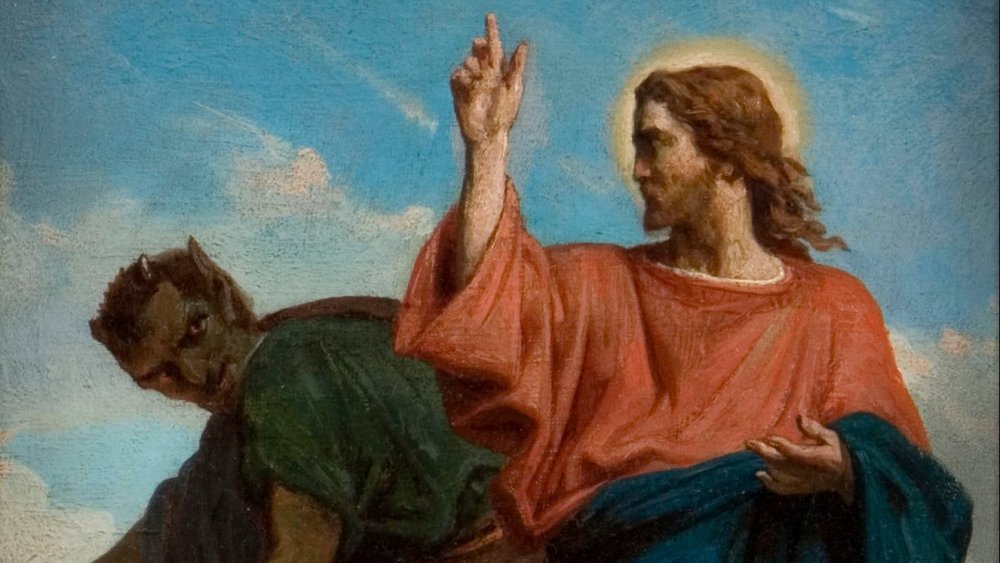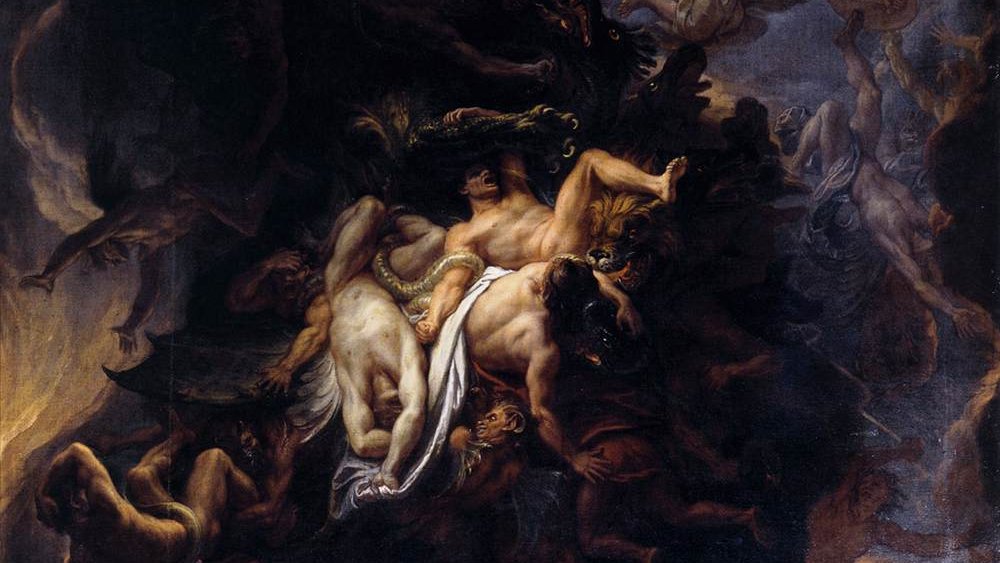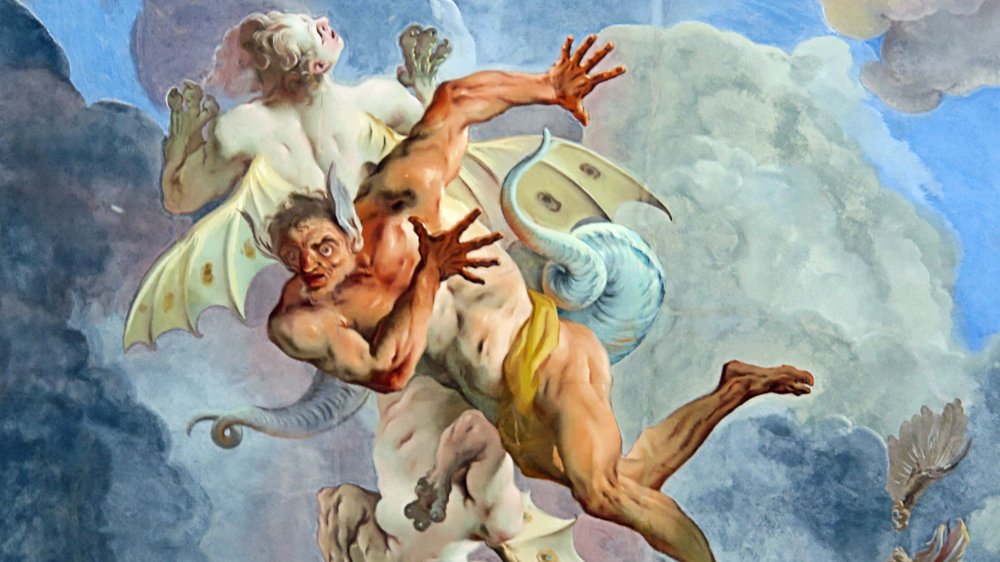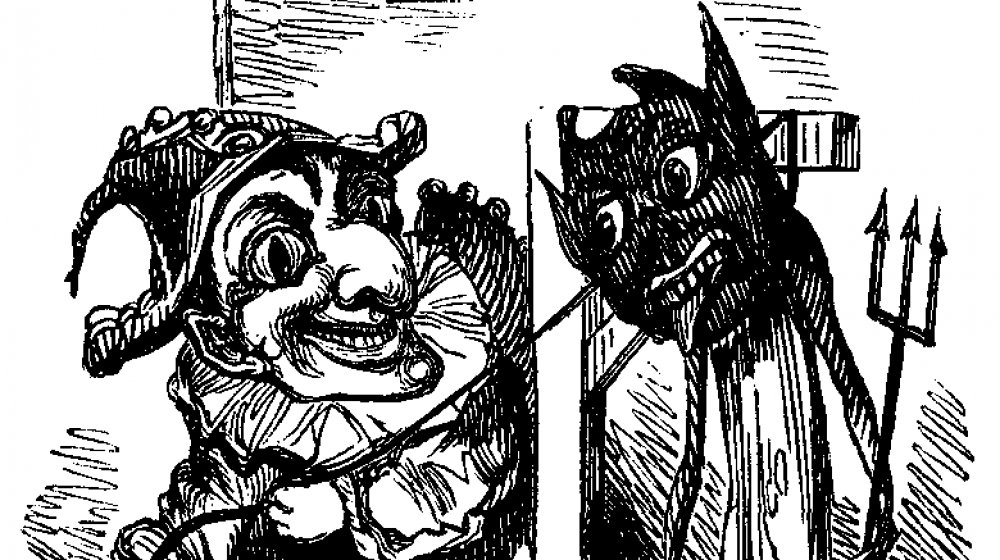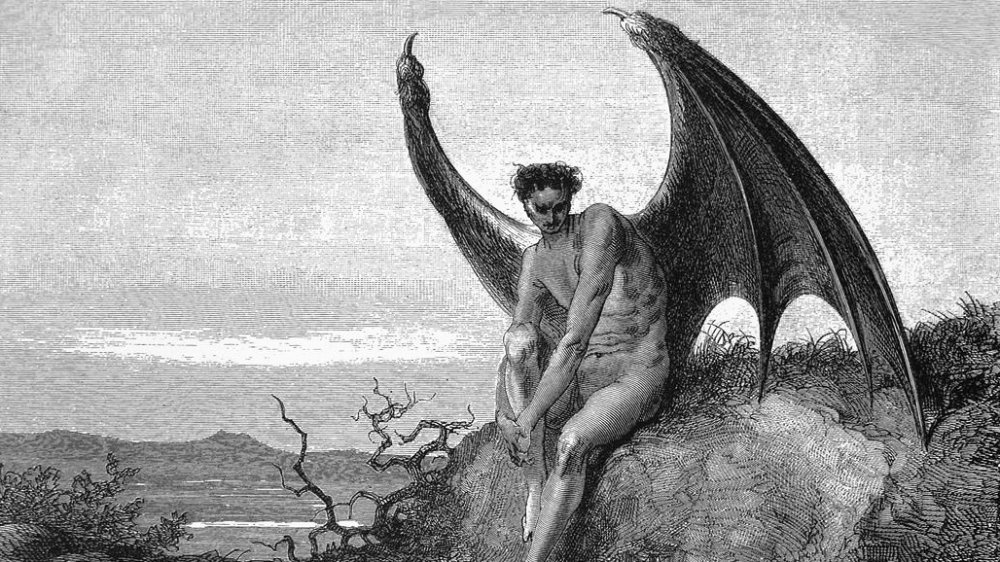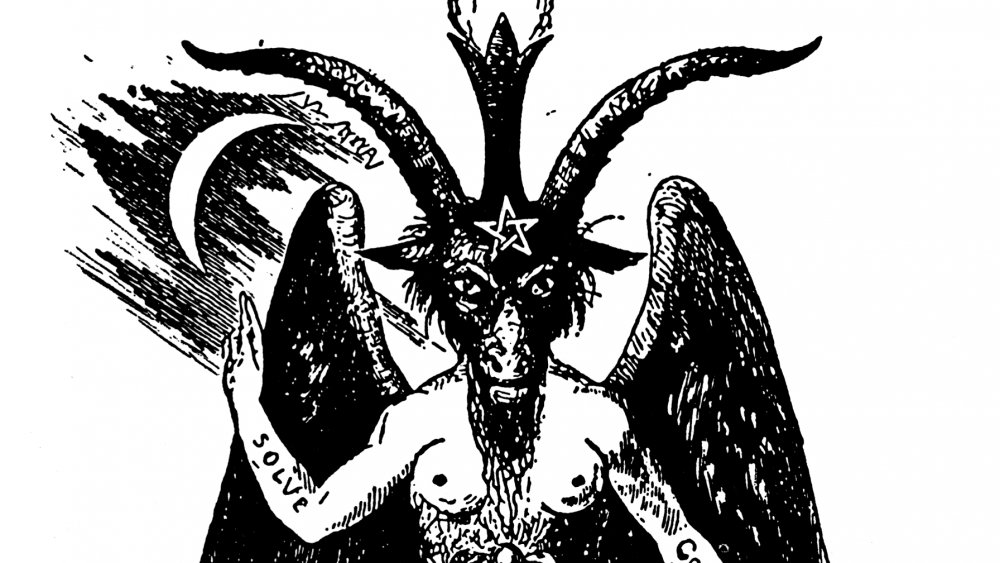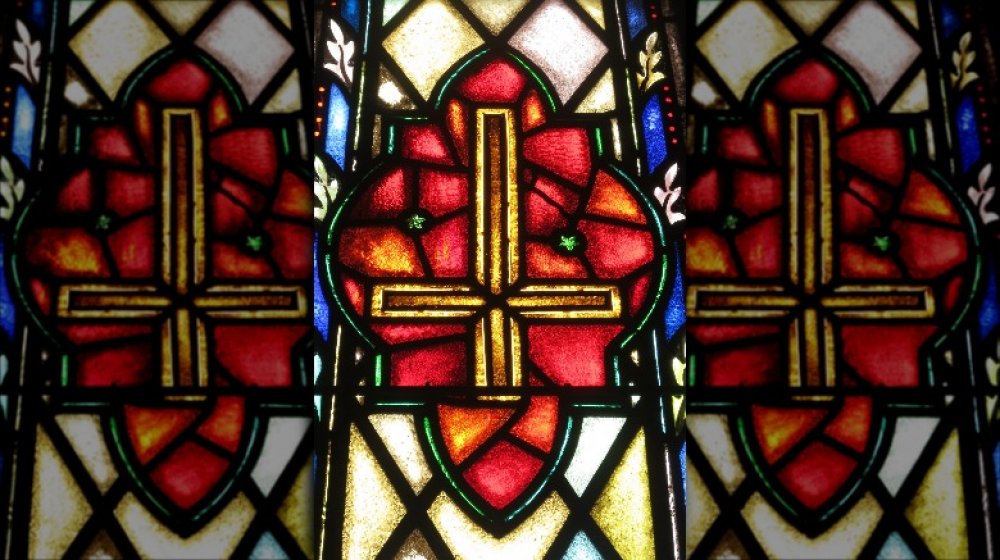Things People Get Wrong About The Devil
The Devil is one of those figures that pretty much everyone has heard of, and pretty much anyone who's heard of him has a good idea of what his deal is. They know what he looks like, what his real name is, what his secret origin story is, and all about how he wages war against God for the souls of humankind from his blazing kingdom of the damned in the depths of Hell.
And while for many people, the Devil is a folkloric figure or even just a metaphor, many others believe in a literal Devil who has real impact on the world. So even though it would be impossible to be "wrong" about a folkloric Devil, if you want to believe in a biblical Devil, you should know what the Bible does — and more often, doesn't – say about him. Spoilers: all the things you know from the first paragraph are wrong.
The Devil isn't God's archenemy
In the popular conception of the Devil, he is the embodiment of pure evil, and as such, he's God's opposite number. The idea is that God and Satan are constantly at war with each other for the souls of humanity, each sending out their angels against the others' in order to destroy their greatest enemy. This view, however, isn't supported by the Bible at all. As the Encyclopedia Britannica points out, it's only in post-biblical Jewish literature that Satan becomes an adversary of God. The idea of Satan as the ruler of fallen angels who rebelled against God simply does not exist in the Hebrew scriptures.
The idea of more or less equal forces of good and evil battling against each other likely entered into Jewish (and subsequently Christian) thinking as a result of the Jews being exposed to the more dualistic religion of Zoroastrianism when they were exiled to Babylon in the 6th century B.C.
While in the New Testament Satan is portrayed more clearly as an enemy of God, he's still not anywhere close to equal in power. The best he can do is try to tempt Jesus into abandoning his mission of salvation and worship him, all of which Jesus resists without much effort. It's only weaker-willed humans like Judas who succumb to Satan's power. Satan and his minions don't stand a chance against Jesus.
The Devil isn't all-powerful
The idea of the Devil as God's evil opposite also creates this image of Satan as being all-powerful, the way God is portrayed in the Bible. Furthermore, he is seen as the origin of evil, a dark creator who brings suffering and ruin into the world at his whim in an attempt to destroy humanity, whom he hates. The Bible, however, paints a very different picture. The Book of Job gives a clearer impression of Satan's relationship to God by showing that he is merely one of a court of heavenly beings who seek God's favor. His power is shown to be limited throughout this book, as he constantly has to ask permission to enact suffering upon Job and his family. He can do nothing without God's express approval.
The Encyclopedia Britannica explains that the Devil cannot be equal with God, as he is a creation of God and in fact his servant, who can only act on God's behalf. Furthermore, the Bible makes it clear that Satan creates nothing, not even evil, as God is the creator of all. The Book of Isaiah says, "I [God] form light and create darkness, I make weal and create woe; I the Lord do all these things." Satan isn't an evil god opposing a good one. He's an accuser, slanderer, and tempter on God's payroll.
Satan isn't the ruler of Hell
You can see the image in any number of movies, cartoons, or newspaper comics: the Devil as the boss of Hell, torturing sinners and welcoming the newly damned to his domain. This extremely common view comes from that same dualistic instinct that makes people think of Satan as God's archenemy: just as God rules Heaven, the Devil too must have his domain. "God good, Devil bad," as the '80s Christian rock classic goes. However, as youth pastor Jeremy Edgar points out, this simply isn't the case. Hell isn't Satan's kingdom. It's his "prison." And he's not even there yet.
The Book of Revelation tells us that "the devil who had deceived them was thrown into the lake of fire and sulfur, where the beast and the false prophet were, and they will be tormented day and night forever and ever." But this is a vision of the future, set to come after Judgment Day, which by most accounts hasn't happened yet.
If he's not in Hell now, where is the Devil? He answers that himself in the Book of Job, saying he has come "from going to and fro on the earth, and from walking up and down on it." So if Satan is meant to be tortured in Hell, who does the torturing? Extracanonical Jewish and Christian literature says it's God's own archangel Uriel.
Satan wasn't the serpent in the Garden of Eden
If you have ever attended Sunday school, it's likely that one of the earliest stories you heard was the account of Adam and Eve in the Garden of Eden and how they were tempted into sin by a serpent who convinced Eve to eat the fruit of the Tree of the Knowledge of Good and Evil. For centuries, the serpent who tricked the first humans into betraying God has been identified with the Devil. However, Old Testament Studies professor John Day explains that nowhere in the text of Genesis is the serpent said to be Satan, and — if you interpret the Bible as a set of documents written by humans and not the divine word of God — the idea of "Satan" hadn't even developed by the time Genesis was written. In fact, it's not until the first century B.C. apocryphal Book of Wisdom that the Devil is blamed for bringing death into the world.
For many Christians, the Book of Revelation makes explicit the connection between the serpent and Satan, with God's angels defeating the dragon (Satan) as the fulfillment of God's statement in Genesis 3 that Eve's offspring would crush the serpent's head. And the allusion in Revelation is probably to the sea serpent Leviathan from Jewish mythology. The Eden serpent is just, as the text explicitly says, "a wild animal that God had made."
Satan's name isn't Lucifer
The Devil is known by many different names, including Satan, Beelzebub, the Father of Lies, Old Scratch, Clootie (if you're Scottish), Iblis (if you're Muslim) and so on. But if you were to ask someone what the Devil's "real" name is, most people would probably say Lucifer. The popular understanding is that Satan was one of God's angels, named Lucifer, who was cast out of Heaven when he rebelled. But, if you're going strictly by biblical texts, the word "Lucifer" is never once applied to Satan. UCLA Professor Henry Ansgar Kelly explains that the word "Lucifer" is the Latin translation of a Hebrew word used to refer to the morning star (now known to be the planet Venus), and it's not until the third century philosopher Origen that anyone connects the falling morning star with Satan falling from Heaven.
What's more is that the word "lucifer," which literally means "light-bringer," appears three times in the New Testament. And in all three occasions, the word is being applied not to the Devil, but to Jesus. Jesus is the morning star because he represents a new day for humanity. Like much of what is commonly believed about Satan and Hell these days, the popularity of Lucifer as a name for the Devil can be traced back to Dante's Inferno and John Milton's Paradise Lost.
Satan's name isn't even Satan
So if Lucifer isn't the Devil's name, what is it? Well, the obvious response to that is to say that his name is Satan. Everyone knows that name. Get thee behind me, etc. The bad news is this: that's not his name either. It's a title. As the Encyclopedia Britannica explains, the English word "Satan" comes from a Hebrew word meaning "adversary," or "one who plots against another." It's used several times in the Hebrew scriptures and very rarely to refer to an evil spirit. It's not his name, it's his job: to roam the earth and seek out people who he can accuse of wrongdoing. He's not capital-S Satan, he's the satan. The Hebrew word gets translated as diabolos ("slanderer") in the Greek Bible, which is the source for the word "devil." So again, a job description.
This is not to say that there are no proper names used to refer to the Prince of Darkness in the Bible. The Gospels refer to the Prince of Demons as Beelzebub, though as that means "lord of the flies," that might be another title or epithet rather than proper name. The best bet for the Devil's real name might be Belial, which is used in both the Hebrew and Christian scriptures, as well as numerous non-canonical texts. In much Jewish literature, the chief devil is given the name Samael, so maybe that's it.
The Devil's backstory isn't hidden in the Old Testament
Because such a big deal is made about the Devil, it's easy to assume that the Bible must be filled with lots of ideas and stories about him. That's not really the case, though. There are only three unambiguous appearances of the Devil in the Hebrew scriptures, with the Book of Job being the only one that's more than a passing reference.
There are two other references in the Jewish prophets that are often identified — inaccurately — as being about Satan. The first is the image of the morning star falling from Heaven (the origin of the name Lucifer) in the Book of Isaiah, and the second is the cherub in Eden described in the Book of Ezekiel. However, Professor Henry Ansgar Kelly explains that the Isaiah passage is merely a metaphor for the fall of a tyrannical Babylonian king, and it's not for hundreds of years that someone drew the connection between this king's fall and Satan's.
Similarly, the blog Dust off the Bible shows that the passage in Ezekiel about the cherub in Eden is a warning to the king of Tyre (subsequently identified as Ithobaal III) that because he has exalted himself as a god, the true God will send invaders to raze his nation. If you read these passages from Isaiah and Ezekiel in context, it's clear that they're denunciations of foreign kings and not a fallen angel.
Satan didn't fall from Heaven...yet
Just as the name Lucifer has been commonly accepted as the "original" name of the Devil, the common understanding is that his origin story, so to speak, is that he was an angel who rebelled against God for various reasons — pride, jealousy, whatever, usually related to the creation of humans. A third of the angels sided with Lucifer and fell from Heaven and became demons. This version of events became fully codified in western culture thanks to the enduring influence of Milton's Paradise Lost. However, as the Logos blog points out, there's no actual evidence of the fall of Satan and his angels in the primary canon of the Bible. The only mention of Satan falling is in Revelation, which is supposed to be referring to future events. Furthermore, the one-third of angels ("stars" in the extended metaphor) that the dragon Satan sweeps down from Heaven might not even be those who took his side, but rather ones he defeated. The text is ambiguous.
So if there's no biblical evidence for a fall of Satan and his angels without reading things into Isaiah and Revelation, where do demons come from? The Bible is unambiguous about the existence of demons. Jewish literature tells us that demons were the ghosts of the Nephilim, the giant offspring of human women and fallen angels who fell not due to Lucifer's pride, but regular old desire for human ladies.
The Devil doesn't have horns and a pitchfork
Even a kid can tell you what the Devil looks like: he's red, with horns, a pointed tail, a pitchfork, a cape, probably a mustache and a little goatee, cloven hooves, and so on. It probably won't surprise you at this point that this image bears no relation whatsoever to the Devil of the Bible. In fact, the Bible never gives a physical description of the Devil at any point. This causes a problem for artists who want to depict Satan for religious illustrations. As Fast Company explains, artists who wanted to portray the Devil — notable among them including Hieronymous Bosch and Albrecht Dürer — had to pull from other sources to decide what a demon and the Prince of Demons looked like, most prominently Greek mythology. As a result, Satan and other biblical demons end up taking on elements of satyrs and fauns, such as cloven hooves, goat legs, and little horns. Satan's pitchfork is likely derived from the trident of the pagan god Poseidon.
Using the goatish figure of Pan and his satyrs as a starting point, medieval artists developed Satan into a bestial figure covered with horns, fur, and eventually scars, boils, and other deformities so that you end up with a figure like the famous illustration from the Codex Gigas. Sometimes also he has faces all over his body, or worse, his butt is also a face.
The Devil doesn't look like a monster at all
While in the Middle Ages illustrators depicted the Prince of Darkness as the grodiest dude they could think of, later portrayals came to depict him as sleeker and more debonair. Milton's Paradise Lost turns him into a tragic hero, but Goethe's Faust goes a step further in turning his Devil figure, Mephistopheles, into a charming, charismatic dandy — one who could easily persuade someone. It's much easier to see Jason Sudeikis's "Weekend Update Devil" or the dude on the can of ham from here than from the boil-covered Devil of the Middle Ages. And in a way, the charming, debonair Devil is closer to the version presented in the Bible.
The Discovery Series rightly points out that as Satan is a spiritual being, he's incorporeal. He has no physical body, so he doesn't look like anything. But even though the Bible never describes the Devil's true form, the apostle Paul does warn the church at Corinth to beware — not of a beastly demon, but of beauty. He says that "even Satan disguises himself as an angel of light." His point is that if the Devil were to present himself to you, it would not be in a beastly form that would terrify you but rather a beautiful form that would fool, tempt, and persuade you, just as false teachers use pretty words to hide the evil of their true messages.
Satanists don't worship Satan
People who believe deeply in Satan often also believe in people who worship him. They might have images of people in black robes sacrificing animals or defacing churches with pentagrams or, like, playing Dungeons and Dragons probably. These fears ultimately led to the feedback loop that was the Satanic panic that hit its highs in the 1980s, with innocent people being accused of harming children to the delight of Satan. But while it's true that there are Satanists out there, all that other stuff is supremely fake. As a real Satanist told the Independent, Satanists don't worship Satan. They don't even believe he's real.
Satanists are atheists for whom Satan is a symbol of rebellion, pride, individualism, and rejection of a Christian-centric status quo. Additionally, Satanism embraces skepticism, so many of the spooky accoutrements that suburban moms likely associate with Satanists — ouija boards, tarot cards, and other implements of magical divination — have no meaning to them other than maybe aesthetics. Their central principles are nevertheless focused on egoism and carnal pleasures: indulgence, vengeance, and ethics based on self-interest. When you keep that in mind, it makes sense when the Satanist in the Independent article says that the majority of Satanists seem to be men between the ages of 20 and 45. So while they may not be sacrificing goats on Halloween like your mom thinks, still ... bleh.
Inverted crosses and pentagrams are not inherently satanic
Two symbols seem to be associated with the worship of Satan more than any other in the public consciousness: the upside-down cross and the pentagram. If you were a teen wanting to freak out "the man," these are definitely the things you would spray paint onto the wall behind your school gym. Furthermore, the presence of a five-pointed star in imagery has caused accusations of Satanism against anyone from Mormon churches to multinational consumer goods corporation Procter and Gamble. The fact is, though, that these symbols have origins within — not against — the Christian church.
The inverted cross — said to be a mockery of Christ's suffering by those who think it Satanic — is, as Catholic Answers explains, a St. Peter's cross. According to Christian tradition, St. Peter was crucified upside down so that he wouldn't appear to be copying Jesus. As a result, this symbol of St. Peter can be seen on any number of bits of papal gear, because Peter was the first pope and all subsequent popes follow in his footsteps. Nonetheless, some people use this as an argument that the pope is the Antichrist.
Meanwhile, Odyssey Online explains that while pentagrams are common symbols in many religions, they were once used to represent the five wounds that Christ received at the crucifixion. As a result, the five-pointed star was actually a protective motif to drive away evil.

